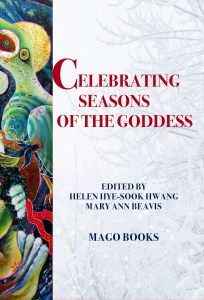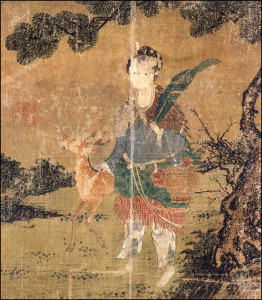Through essays, poetry, art, and ritual, this anthology addresses the ways we acknowledge the yearly cycle. It is fascinating heartfelt tribute to the Goddess of the Year by women who dedicate their lives to her.
Helen Hye-Sook Hwang explains the Mago calendar in detail, exploring its history, numerology, practicality, and theoretical basis. It’s a way of marking time that works well for perennial calendars. There’s a lot of food for thought here, but I will defer an in-depth exploration for another time.
There are two essays about the Cailleach (the Goddess as Crone). Jude Lally explains the meaning of Cailleach on the British Isles and Judith Shaw relates her personal experience with this goddess. There is as much emphasis on place as on time in this collection. Harita Meenee discusses the symbolism of the pomegranate and its relationship to seasons and folk customs. Glenys Livingstone ponders the meaning for feminists of Mary as Christian Goddess. Sara Wright relates her pilgrimage to Georgia O’Keefe’s haunts in New Mexico. Anna Tzanova shares her spiritual journey with food through preparation of a Korean sweet rice dish called Yaksik, eaten at the beginning of the Korean new year. Mary Ann Beavis narrates a set of photographs she took of a wild polar bear family in the Arctic Circle. This is just a sampling of what is offered. I also have several contributions to the anthology.
This anthology spans such a wide range of religions, places, perspectives, and spiritual mediums that I am having a hard time characterizing it, but it does fit together well. Most of the articles are short, and it’s the type of book you don’t necessarily read sequentially. The artwork is fabulous. I was impressed with many of the the artists’ use of color, as color is such an expression of seasonal change.
Celebrating Seasons of the Goddess is your gift book for this holiday season. It will delight any woman who enjoys reading about the Goddess.



